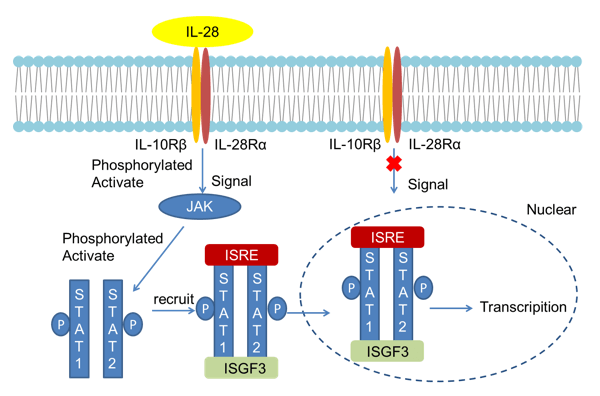Introduction
Interleukin-28 (IL-28A, IL-28B) is a group of new interleukins produced by a variety of cells induced by viruses or double-stranded RNA, such as peripheral blood mononuclear cells (PMBC), dendritic cells ( DC) and HeLa cells. Its genetic structure is similar to IL-10, but its amino acid level is closer to interferon (IFN). So Kotenko et al. also refer to them accordingly as IFN-λ2 (IL-28A) and IFN-λ3 (IL-28B). It can bind to a heterodimeric type II cytokine receptor composed of IL-10Rβ and IL-28Rα, and exerts its antiviral or other defense functions through the Jak-STAT signaling pathway. The newly discovered IL-28 has similar functions to class I IFN and can selectively act on different types of target cells. They can be used as a substitute for IFN for the treatment of tumors and viral diseases.
Mechanism and Function
The ligands of the class Ⅱ cytokine recep 2 torfamily include the IFN family and the IL-10 family. The human IL-28 gene is located on chromosome 19, and the IL-28A and IL-28B genes contain 6 exons, which is similar to the IL-10 family genes, but very different from the class IFN gene with only one exon. IL-28A and IL-28B are composed of 22-amino acid signal peptide and 174-amino acid mature peptide. The relative molecular mass of IL-28A and IL-28B is about 22000, with three disulfide bonds and no glycosylation. The disulfide bond is very important for the correct folding and biological activity of IL-28. IL-28 is a ligand of the class II cytokine receptor family, and its gene has a certain homology with IL-10.
Experiments show that IL-28 must bind to the receptor before it can function. The IL-28 receptor is a heterodimeric type II cytokine receptor, which is composed of the IL-10 receptor β subunit (IL-10Rβ also known as IL-10R2, CRF2-4) and IL-28Rα or IFN-λR1, CRF2-12). IL-10Rβ is also a component of IL-10 and IL-22 receptors. IL-28Rα determines the specificity of binding to IL-28, and may mediate intracellular signaling. IL-28 binds to its receptor and transmits information through Jak-STAT pathway. First, after IL-28 binds to the receptor, it initiates a signaling cascade. After a multi-step phosphorylation reaction, STAT2 is activated, resulting in the interaction of IFN-stimulated gene factor 3 complex (ISGF3) and IFN-stimulated response element (ISRE), thereby regulating gene transcription.
The main functions of IL-28 include anti-virus, anti-cell proliferation and immune regulation. They are similar to IFN by inducing cells to produce a variety of intracellular proteins, which mediate their biological activity. IL-28 can induce the expression of two antiviral proteins. 2 ', 5'-oligoadenylate synthetase (2 ′, 5′-OAS) can catalyze the formation of a special oligonucleotide, and activate the endonuclease RNaseL. The activated RNaseL can degrade viral RNA, thereby inhibiting the viral protein synthesis. MxA protein belongs to GTPase, which can block the replication of some orthomyxoviruses. The antiviral activity of IL-28 is similar to IFN, but it is selective for target cells. The anti-cell proliferation effect of IL-28 varies greatly among different target cells. IL-28 enhances the expression of MHC class I molecules in target cells, promotes cell processing and antigen presentation, and enhances antiviral specific immune responses.
 Fig 1. Mechanism of Signaling
Fig 1. Mechanism of Signaling
Creative Proteomics can provide cytokine detection platform for scientific research. According to different purposes, our dedicated analysts will customize exclusive solutions for you. We aim to provide customers with high-quality and convenient services to help you accelerate the progress of your project.
Our cytokine detection service includes but is not limited to:
- One or more cytokines qualitative and quantitative detection
- Cytokines qualitative and quantitative detection of various species
- Cytokine antibodies qualitative and quantitative detection
Sample requirements
- Sample Types- Serum, plasma, cell culture supernatant and other biological samples, etc.
- Sample Volume - It is optimal for 50 samples. This volume allows for triplicate testing of each sample.
Our advantages:
- Different detection methods can be selected based on different samples and requirements.
- Ensure the specificity and accuracy of the test by using high quality antibodies.
- Repeat the test to ensure the repeatability and accuracy of the experimental results.
- Feedback results are accurate and efficient.
Technology platform:
We mainly provide the Luminex cytokine detection platform. Luminex uses fluorescently encoded microspheres with specific antibodies to different target molecules. The different microspheres can be combined freely to a certain extent so that up to 100 analytes can be tested multiple times simultaneously in a single experiment.
The Luminex cytokine assay platform has the following advantages:
- Multiple detection: simultaneous detection of 100 biological targets
- Short experiment time: 1-3 weeks
- High sensitivity: the lower limit of accurate quantification is as low as 0.1 pg/mL
- Save samples: only need a sample volume as low as 25 μL
- Time saving: the experiment process only takes 4 hours
For your different needs, we can also provide the following detection methods:
- Enzyme-linked immunosorbent assay (ELISA)
- Flow cytometry
Workflow

For more information about the IL-28 detection service or need other detection requirements, please contact us.
References:
- Sheppard P, et al. IL-28, IL-29 and their class II cytokine receptor IL-28R[J ]. Nature Immunol , 2003,4(1) : 63 2 68.
- Kotenko SV, et al. IFN-λs mediate antiviral protection through a distinct class II cytokine receptor complex[J ]. Nature Immunol , 2003,4(1) : 69 2 77.



